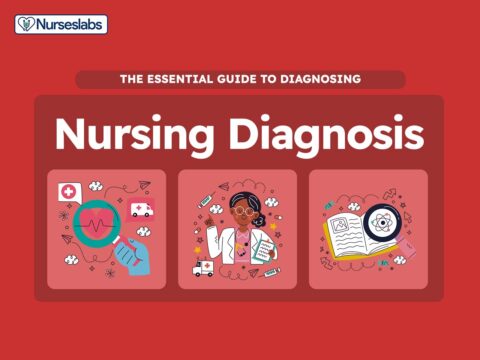This care plan and management guide helps you effectively care for patients with dehydration or fluid volume deficit. It includes assessments, interventions, goals, and nursing diagnoses tailored to address dehydration, ensuring you meet your patients’ needs efficiently. Use this nursing diagnosis and care plan guide to enhance your understanding and deliver quality care for managing dehydration.
What are Fluid Volume Deficit and Dehydration?
Fluid volume deficit (also known as hypovolemia, deficient fluid volume) is a state or condition where the fluid output exceeds the fluid intake. It occurs when the body loses both water and electrolytes from the ECF in similar proportions. FVD should not be confused with dehydration, however; dehydration refers to loss of water alone, with increased serum sodium levels.
Fluid volume deficit results from the loss of body fluids and occurs more rapidly when coupled with decreased fluid intake. Common sources of fluid loss are the gastrointestinal tract, polyuria, and increased perspiration. Risk factors for deficient fluid volume are as follows: vomiting, diarrhea, GI suctioning, sweating, decreased intake, nausea, inability to gain access to fluids, adrenal insufficiency, osmotic diuresis, hemorrhage, coma, third-space fluid shifts, burns, ascites, and liver dysfunction. Fluid volume deficit may be an acute or chronic condition managed in the hospital, outpatient center, or home setting.
Dehydration, on the other hand, can be categorized according to osmolarity and severity.
- Isonatremic or isotonic dehydration
This occurs when the lost fluid is similar in sodium concentration to the blood. Causes are vomiting, diarrhea, sweating, burns, intrinsic kidney disease, hyperglycemia, and hypoaldosteronism. - Hyponatremic or hypotonic dehydration
This occurs when the lost fluid contains more sodium than the blood (loss of hypertonic fluid). Relatively more sodium than water is lost. This is mostly caused by diuretics. - Hypernatremic or hypertonic dehydration
This occurs when the lost fluid contains less sodium than the blood loss (loss of hypotonic fluid). Relatively less sodium than water is lost. Etiologies are fever, increased respiration, and diabetes insipidus.
Older adults and pediatric clients are more likely to develop fluid imbalances. Infants’ and children’s higher body water content, along with their higher metabolic rates and increased body surface area to mass index, contribute to their higher turnover of fluids and solutes. Therefore, infants and children require proportionally greater volumes of water than adults to maintain their fluid equilibrium and are more susceptible to dehydration and hypovolemia (Koyfman & Waseem, 2018).
Appropriate management is vital to prevent potentially life-threatening hypovolemic shock. Hypovolemic shock refers to a medical or surgical condition in which rapid fluid loss results in multiple organ failure due to inadequate circulating volume and subsequent inadequate perfusion (Kolecki & Brenner, 2016). The management goals are to treat the underlying disorder and return the extracellular fluid compartment to normal, restore fluid volume, and correct any electrolyte imbalances.
Causes
Here are the common factors or etiology for fluid volume deficit or hypovolemia:
Renal
- Diuretic excess
- Mineralocorticoid deficiency
- Ketonuria
- Osmotic diuresis
- Cerebral salt-wasting syndrome
- Salt-wasting nephropathies
Extrarenal
- Vomiting
- Diarrhea
- Third spacing of fluid
- Burns
- Pancreatitis
- Trauma
- Bleeding
Common causes of dehydration include:
- Gastroenteritis
- Stomatitis
- Diabetic ketoacidosis
- Febrile illness
- Pharyngitis
- Burns
- Congenital hyperplasia
- Diabetes insipidus
Nursing Care Plans and Management
The nursing care plans and management strategies for fluid volume deficit and dehydration focus on restoring fluid balance and preventing further complications. Nurses are responsible for assessing and monitoring the client’s condition, implementing appropriate and effective interventions, and providing education to both the client and their caregivers.
Nursing Problem Priorities
The following are the nursing priorities for clients experiencing dehydration or hypovolemia:
- Identifying the underlying causes. Establishing the etiology of the client’s hypovolemia or dehydration is of utmost importance to properly tailor management.
- Restoring fluid and electrolyte balance. The primary concern for clients is restoring the body’s fluid and electrolyte balance. Addressing this problem requires close monitoring of the client’s fluid intake and output, administration of appropriate intravenous fluids and rehydration solutions, and assessing the client’s response to the therapy.
- Preventing hypovolemic shock. Hypovolemia and dehydration can lead to compromised tissue perfusion due to decreased blood volume and inadequate oxygen delivery to the tissues.
- Client and caregiver education. Hypovolemia and dehydration can have serious consequences, including permanent damage and death. Thus, clients and their caregivers should be educated on signs and symptoms of low volume status and get prompt medical assistance in these situations.
Nursing Assessment
Nursing assessment is a vital aspect of the care plan for clients with hypovolemia and dehydration as it helps identify the underlying causes, monitor the client’s fluid status, and implement appropriate nursing interventions to promote optimal health outcomes. A thorough nursing assessment includes careful evaluation of vital signs, fluid intake and output, and electrolyte levels, and provides critical information for the development of a comprehensive care plan.
The following are the common signs and symptoms presented for dehydrated clients presenting fluid volume deficit that can help guide your nursing assessment:
- Alterations in mental state
- Verbalizations of weakness and thirst that may or may not be accompanied by tachycardia or weak pulse
- Weight loss (depending on the severity of fluid volume deficit)
- Concentrated urine, decreased urine output
- Dry mucous membranes, sunken eyeballs
- Weak pulse, tachycardia
- Fever
- Decreased skin turgor
- Hypotension
- Hemoconcentration
- Delayed capillary refill
- Depressed fontanels in pediatric clients
- Decreased or absent tear production
Nursing Diagnosis
After thorough assessment, nursing diagnoses are formulated to address the challenges of dehydration, guided by the nurse’s clinical judgment and understanding of the patient’s unique condition. While nursing diagnoses help organize care, their use may vary across clinical settings. Ultimately, the nurse’s expertise and judgment shape the care plan to prioritize each patient’s needs. Here are examples of nursing diagnoses that may be useful for common concerns associated with fluid volume deficit or deficient fluid volume:
- Fluid Volume Deficit related to excessive fluid loss and inadequate fluid intake secondary to vomiting and diarrhea as evidenced by dry mucous membranes, decreased urine output, and orthostatic hypotension.
- Fluid Volume Deficit related to third spacing of fluids as evidenced by edema and decreased skin turgor secondary to severe burns.
- Fluid Volume Deficit related to frequent loose stools as evidenced by loose stools, electrolyte disturbances, and dehydration secondary to infectious colitis.
- Fluid Volume Deficit related to vomiting and diarrhea as evidenced by dry mucous membranes, sunken eyes, and decreased skin turgor secondary to acute gastroenteritis.
- Fluid Volume Deficit related to persistent diarrhea as evidenced by loose stools, dehydration, and electrolyte disturbances secondary to Crohn’s disease.
Nursing Goals
Here are some example goals and outcomes for fluid volume deficit:
- The client is normovolemic as evidenced by systolic BP greater than or equal to 90 mm HG (or client’s baseline), absence of orthostasis, HR 60 to 100 beats/min, urine output greater than 30 mL/hr, and normal skin turgor.
- The client demonstrates lifestyle changes to avoid the progression of dehydration.
- The client verbalizes awareness of causative factors and behaviors essential to correct the fluid deficit.
- The client explains measures that can be taken to treat or prevent fluid volume loss.
- The client describes symptoms that indicate the need to consult with a healthcare provider.
Nursing Interventions and Actions
Therapeutic interventions and nursing action for clients with hypovolemia or dehydration may include:
1. Assessment and Monitoring
Fluid volume deficit usually is the result of a primary disorder and clinical manifestations are closely related to the primary cause. Symptoms are usually non-specific. A complete physical examination may assist in determining the underlying cause of the client’s fluid volume deficit and in defining its severity.
Monitor and document vital signs, especially blood pressure (BP) and heart rate (HR).
Changes in BP and HR can indicate hypovolemia, electrolyte imbalances, or compensation mechanisms. Irregular pulse and weak pulse may suggest electrolyte imbalances and hypovolemia. Orthostatic hypotension, indicated by a significant drop in BP and/or HR upon standing, can be a sign of fluid volume deficit. Hypotension will not appear until significant dehydration is present. Tachycardia may also be absent due to medications such as beta-blockers (Taylor & Jones, 2022).
Obtain the client’s history meticulously.
Obtaining accurate history remains crucial in all clinical encounters. In one survey, the parameter most commonly used by inpatient house staff for assessing volume status was a client’s history. Attention should be paid to cardiac history and fluid balance. For clients in the hospital setting, the recorded fluid balance or daily weights will aid in assessing volume status. Unfortunately, these records are not always available or accurate (Elhassan et al., 2021).
Assess skin turgor and oral mucous membranes for signs of dehydration.
Skin turgor and mucous membrane moisture provide valuable indicators of hydration status. Decreased skin turgor and dry mucous membranes are signs of dehydration. In a healthy person, pinched skin immediately returns to its normal position when released. However, this elastic property is partially dependent on interstitial fluid volume. Skin turgor is usually assessed by pulling the skin and observing how long it takes to return to the baseline state; with values longer than two seconds associated with dehydration (Bak et al., 2017). The degree of oral mucous membrane moisture is also assessed; a dry mouth may indicate either FVD or mouth breathing.
Observe tongue turgor regularly.
Tongue turgor is not affected by age, and evaluating this may be more valid than evaluating skin turgor. In a normal person, the tongue has one longitudinal furrow. In a person with a fluid volume deficit, there are additional longitudinal furrows and the tongue is smaller because of fluid loss.
Assess capillary refill appropriately.
Capillary refill can be measured by pressing the distal phalange of the middle finger and then releasing it to calculate the time the blood returns to the finger bed. Classically, this happens within two seconds in men and up to four seconds in women. A delayed capillary refill might be useful only in severe hypovolemia but does not appear to be useful in mild to moderate degrees of blood loss. A delayed capillary refill of more than four seconds was found to be associated with higher prehospital mortality in clients with septic shock (Elhassan et al., 2021).
Assess alteration in mentation/sensorium, such as confusion, agitation, or slow responses.
Changes in mentation can result from electrolyte imbalances, acidosis, or decreased cerebral perfusion caused by fluid volume deficit. Mental function is eventually affected, resulting in delirium in severe fluid volume deficit as a result of decreasing cerebral perfusion. The client may appear lethargic or obtunded upon observation in severe cases of dehydration (Taylor & Jones, 2022).
Assess color and amount of urine; report urine output less than 30 ml/hr for two consecutive hours.
Monitoring urine output helps assess renal function and adequacy of fluid replacement. Urine output below 30 ml/hr may indicate inadequate fluid volume. As fluid volume deficit develops, body fluid losses exceed fluid intake through excessive urination or polyuria, diarrhea, vomiting, or other mechanisms. Once FVD has developed, the kidneys attempt to conserve body fluids, leading to a urine output of less than 1 mL/kg/hour in an adult.
Monitor and document temperature.
Fever increases insensible water loss, contributing to fluid volume deficit. Monitoring temperature helps identify potential fluid imbalance. Fever itself is typically a result of an immune response to infection, and it causes an increase in the body’s core temperature. When the body temperature rises, it can lead to increased fluid loss through sweating, which can contribute to dehydration. However, fever can also occur without dehydration.
Monitor fluid status in relation to dietary intake.
Monitoring fluid intake and output helps evaluate fluid balance and adequacy of dietary fluid intake. To assess for fluid volume deficit, the nurse monitors and measures fluid intake and output at least every 8 hours, and sometimes hourly. Researchers have reported that maintaining an accurate I&O is a particular challenge with clients in critical care settings.
Note the presence of nausea, vomiting, and fever.
Nausea, vomiting, and fever can lead to fluid losses and contribute to fluid volume deficit. Gastroenteritis is the most common cause of dehydration. If both vomiting and diarrhea are present, dehydration may rapidly progress (Huang & Corden, 2018).
Auscultate and document heart sounds; note rate, rhythm, or other abnormal findings.
Dysrhythmias can result from electrolyte imbalances and fluid volume deficits. Monitoring heart sounds helps identify cardiovascular complications. In a client with trauma exhibiting hemorrhage, the causes may include cardiac tamponade, which has muffled heart tones. This could be life-threatening and should therefore be monitored closely (Kolecki & Brenner, 2016).
Monitor serum electrolytes and urine osmolality; report abnormal values.
Abnormal electrolyte levels and urine osmolality can indicate fluid volume imbalance and guide appropriate interventions. Urine osmolality can be greater than 450 mOsm/kg because the kidneys try to compensate by conserving water. Urine-specific gravity may be increased in relation to the kidney’s attempt to conserve water and is decreased with diabetes insipidus.
Ascertain whether the client has any related heart problem before initiating parenteral therapy.
Clients with pre-existing heart conditions may be more susceptible to fluid volume deficit and dehydration, and careful monitoring and management are required. Fluid resuscitation, as an important treatment for early management, is necessary to resolve tissue and organ hypoperfusion. However, excessive fluid intake can worsen congestive symptoms and increase the risk of poor prognosis for heart failure clients (Zhang & Guo, 2022).
Weigh the client daily with the same scale, preferably at the same time of day.
Daily weight measurements provide valuable data on fluid balance and can help detect changes indicative of fluid volume deficit or excess. An acute loss of 0,5 kg (1.1 lb) represents a fluid loss of approximately 500 mL (1 L of fluid weighs approximately 1 kg or 2.2 lbs).
Identify the possible cause of the fluid disturbance or imbalance.
Understanding the underlying cause of fluid volume deficit helps tailor interventions and address the root problem. Poor fluid intake, excessive fluid output, increased insensible fluid losses, or a combination of the above may cause intravascular volume depletion. Successful treatment requires the identification of the underlying disease state (Huang & Corden, 2018).
Monitor active fluid loss from wound drainage, tubes, diarrhea, bleeding, and vomiting; maintain an accurate input and output record.
Monitoring fluid losses helps determine the extent of fluid volume deficit and guides appropriate fluid replacement. Wound drainages are used in certain surgical procedures or to manage specific types of wounds. They are designed to remove excess fluid, such as blood or serous fluid, from the wound site.
During treatment, monitor closely for signs of circulatory overload, such as headache, flushed skin, tachycardia, venous distention, elevated central venous pressure (CVP), shortness of breath, increased BP, tachypnea, and cough.
Vigilant monitoring for signs of circulatory overload helps prevent complications associated with excessive fluid replacement. Fluid replacement complications can occur, especially when large volumes are given rapidly. Therefore the nurse monitors the client closely for cardiovascular overload and signs of difficulty breathing, a condition known as transfusion-associated circulatory overload.
Monitor and document hemodynamic status, including CVP, pulmonary artery pressure (PAP), and pulmonary capillary wedge pressure (PCWP) if available in the hospital setting.
Monitoring hemodynamic parameters provides valuable information on the fluid status and guides appropriate interventions. Advanced hemodynamic parameters such as cardiac filling pressures, CVP, and volumetric preload parameters such as intrathoracic blood volume index have been used to approximate cardiac preload and to appropriately guide fluid resuscitation (Reyes, 2023).
Monitor for the existence of factors causing deficient fluid volumes, such as gastrointestinal losses, difficulty maintaining oral intake, fever, uncontrolled type II diabetes mellitus, and diuretic therapy.
Identifying and addressing factors contributing to fluid volume deficit helps prevent further imbalances and complications. The majority of fluid loss occurs in urine, stool, and sweat but is not limited to those avenues. Insensible fluid loss is the amount of body fluid lost daily that is not easily measured, from the respiratory system, skin, and water in the excreted stool (McNeil-Masuka & Boyer, 2022).
Monitor laboratory studies, such as complete blood count (CBC), electrolyte levels, and renal function tests, as indicated.
Regular monitoring of laboratory values helps assess the severity of fluid volume deficit, guide appropriate fluid replacement therapies, and monitor the client’s response to treatment. A volume-depleted client has a BUN elevated out of proportion to the serum creatinine. The hematocrit level is greater than normal because there is a decreased plasma volume. Potassium and sodium levels can be reduced.
Monitor oxygen saturation through continuous central venous oximetry.
Continuous central venous oximetry monitoring may be used to evaluate mixed venous blood oxygen saturation and severity of tissue hypoperfusion states. A central catheter is introduced into the superior vena cava and a sensor on the catheter measures oxygen saturation of the blood in the SVC as blood returns to the heart and pulmonary system for reoxygenation.
Assess the client’s readiness and ability to manage oral fluid intake. Provide assistance, if needed, to ensure adequate hydration.
Some clients may require support in managing their oral fluid intake due to physical limitations, cognitive impairments, or other factors. Assisting with hydration promotes optimal fluid balance. The nurse performs a functional assessment to determine fluid and food needs and to obtain adequate intake in addition to a physical assessment. Results of this assessment have a direct bearing on how the client will be able to meet their own need for fluid and foods.
Continuously evaluate and reassess the effectiveness of interventions and modify the fluid management plan as needed.
Regular evaluation and modification of the fluid management plan ensure ongoing optimization of fluid volume balance and prevention of complications. If the deficit cannot be corrected by oral fluids, therapy may need to be initiated by an alternative route until adequate circulating blood volume and renal perfusion are achieved.
Assess the client’s extremities as appropriate.
Decreased peripheral perfusion can result in cold extremities. In clients with relatively normal cardiopulmonary function, a low central venous pressure is indicative of hypovolemia. Clients with acute cardiopulmonary decompensation require more extensive hemodynamic monitoring of pressures on both sides of the heart to determine whether hypovolemia exists.
Utilize point-of-care ultrasound (POCUS), if available.
POCUS is suggested or endorsed by many internal medicine societies to assist healthcare providers with diagnosing and treating many common pathologies. It can be promising for volume status assessment. Images and clinical information can be obtained relatively quickly from different organs including the lungs, heart, and large vessels to inform medical decisions regarding fluid management. A blood loss of as low as 450 mL decreased the inferior vena cava (IVC) diameter by a mean of around 0.5 cm in 31 volunteers after blood donation, as detected by IVC POCUS. Cardiac POCUS can detect the hypercontractility of the left ventricle in clients with hypovolemia (Elhassan et al., 2021).
Monitor for progressive edema formation closely in clients suffering from severe burns.
Edema forms rapidly after a burn injury. A superficial burn will cause edema to form within four hours, whereas a deeper burn will continue to form edema up to 18 hours post-injury. This is caused by increased perfusion to the injured area in the presence of increased capillary permeability and reflects the amount of microvascular and lymphatic damage to the tissue. In burns greater than 30% TBSA, inflammatory mediators stimulate local and systemic reactions resulting in extensive shifts of intravascular fluid, electrolytes, and proteins into the surrounding interstitium.
Perform a fluid challenge test as indicated.
A client with severe FVD may have a fluid challenge test. Volumes of fluid are given at specific rates and intervals while the client’s hemodynamic response to this treatment is monitored. The goal is to provide fluids rapidly enough to attain adequate tissue perfusion without compromising the cardiovascular system.
Assessment for pediatric clients
Assess the degree of dehydration by observing and recording the pediatric client’s weight.
Dehydration has three categories: mild, moderate, and severe. In mild dehydration, the child loses 3% or 30 mL/kg, in moderate dehydration, 6% or 60 mL/kg, and in severe dehydration, 9% or 90 mL/kg. An infant loses 5% or 50 mL/kg in mild dehydration, 10% or 100 mL/kg in moderate dehydration, and 15% or 150 mL/kg in severe dehydration. A pediatric client with mild dehydration exhibits the following signs:
- Alert level of consciousness
- A capillary refill of two seconds
- Normal mucous membranes
- Normal tear production
- Slightly increased heart rate
- Normal respiratory pattern
- Normal blood pressure and pulse rate
- Normal skin turgor and fontanels
- Decreased urine output
A child with moderate dehydration may exhibit the following:
- Lethargy, listlessness, irritability
- Capillary refill of two to four seconds
- Dry mucous membranes
- Decreased tear production
- Increased heart rate and respiratory rate
- Orthostatic hypotension
- Thready pulse
- Slow skin turgor
- Depressed fontanels
- Sunken eyes
- Oliguria
A child with severe dehydration has the following signs:
- Obtundation
- More than four seconds of capillary refill and cool-to-the-touch limbs
- Parched, cracked mucous membranes
- Absent tears
- Tachycardia and tachypnea with hyperpnea
- Hypotension
- Faint or impalpable pulse
- Tenting of the skin upon pinching
- Sunken eyes and fontanels
- Oliguria or anuria
Obtain a complete history of the pediatric client from parents or caregivers.
Obtaining a complete history from the parent or caregiver is important because it provides clues to the type of dehydration present. The nurse may observe the child’s feeding pattern and the fluids given, fluid loss through vomiting or diarrhea, number of wet diapers compared with the normal, activity level, possible ingestions that caused vomiting, heat and sunlight exposures, current illness pattern, fever, ill contacts, and recent weight prior to current illness (Koyfman & Waseem, 2018).
Monitor the child’s laboratory results closely.
Dehydration could be associated with hypo or hyper or isonatremia. Most cases of dehydration are hyponatremic. In selected cases, electrolyte abnormalities may exist. This includes derangements in sodium levels, acidosis characterized by low bicarbonate levels or elevated lactate levels. For clients with vomiting who have not been able to tolerate oral fluids, hypoglycemia may be present (Vega, 2022).
Perform a bedside POCUS if available.
Bedside ultrasound has also been used to measure the inferior vena cava and the aorta diameter ratio and has been found to be a marginally accurate measurement of acute weight loss in children with dehydration due to gastroenteritis (Koyfman & Waseem, 2018).
Assessment for older adults
Determine the older adult’s ability for adequate fluid and food intake.
The nurse may perform a functional assessment of the older adult’s ability to determine fluid and food needs and obtain adequate intake. For example, the client may not be cognitively intact, able to ambulate and use both arms and hands to reach fluids and foods, and unable to swallow effectively. This may determine the assistance that the older adult may need to fulfill food and fluid intake.
Avoid relying on the results of skin turgor assessment for older adults.
In most adult clients, it is useful to monitor skin turgor to detect subtle changes. However, assessment of skin turgor is not as valid in older adults because the skin has lost some of its elasticity; therefore, other assessment measures may become more useful in detecting fluid volume deficit.
Observe the fluid intake of clients with incontinence.
The nurse should recognize that some older adults deliberately restrict their fluid intake to avoid embarrassing episodes of incontinence. In this situation, the nurse should identify interventions to deal with the incontinence.
Assess the older adult’s oral mucous membranes.
Dehydration is associated with decreased secretion of bodily fluids and it is expected that small production of saliva may be an indication of deteriorating hydration status. A small saliva pool was also reported in dehydrated older adults. Certain conditions such as Alzheimer disease are also associated with dry oral mucosa (Bak et al., 2017).
Monitor the client’s level of consciousness closely.
Changes of consciousness have been reported by some studies and dehydration is frequently mentioned as a risk factor for delirium. These signs were found out to be 49% sensitive and 99% specific. However, changes in consciousness may be difficult to diagnose in older adults since many may suffer from dementia and are also susceptible to delirium due to other reasons (Bak et al., 2017).
2. Prevention of Fluid Volume Deficit and its Complications
Prevention is a fundamental aspect of healthcare, and for a condition such as fluid volume deficit, proactive measures play an essential role. By focusing on prevention, the occurrence and impact of fluid volume deficit can be minimized. Through education, awareness, and proactive measures, the aim is to maintain optimal fluid balance, promote overall health, and prevent the potential complications associated with these conditions.
Provide facial skin cooling or cold compresses to the forehead and cheeks.
Cooling the forehead and cheeks stimulates the trigeminal nerve, which elicits an increase in cardiac parasympathetic activity followed by a rise in sympathetic activity. Despite the transient increase in cardiac parasympathetic activity, face cooling causes substantial increases in blood pressure that can be maintained for 15 minutes or more. Simply cooling the forehead and cheeks might be an effective intervention to maintain or improve blood pressure in hypovolemia (Johnson et al., 2017).
Encourage interventions to prevent or minimize future episodes of dehydration.
A client needs to understand the value of drinking extra fluid during bouts of diarrhea, fever, and other conditions causing fluid deficits. During gastroenteritis, the intestinal mucosa retains absorptive capacity. Sodium and glucose in the correct proportions can be passively cotransported with fluid from the gut lumen into the circulation. Rapid oral rehydration with the appropriate solution has been shown to be as effective as intravenous fluid therapy in restoring intravascular volume (Huang & Corden, 2018).
Implement measures to prevent and manage complications associated with fluid volume deficit, such as deep vein thrombosis (DVT) prophylaxis, regular repositioning, and skin care.
Fluid volume deficit increases the risk of complications such as DVT and pressure injuries. Implementing preventive measures reduces the likelihood of these complications. The prognosis for clients suffering from hypovolemia depends on the underlying etiology and prompt management of the fluid status. There is a high risk of permanent damage such as cardiac arrhythmias, cerebral hypoperfusion, and multi-organ failure if left untreated (Reyes, 2023).
Collaborate with the dietitian to develop a balanced diet plan that meets the client’s nutritional needs while considering fluid restrictions, if applicable.
Adequate nutrition supports overall health and helps optimize fluid balance. Dietitians can develop personalized meal plans that take into account the client’s fluid restrictions or preferences. They can help identify foods and beverages that are hydrating and provide necessary electrolytes.
Create an emergency plan, including when to ask for help.
Some complications of deficient fluid volume cannot be reversed in the home and are life-threatening. Clients progressing toward hypovolemic shock will need emergency care. Appropriate treatment usually can be initiated without delaying transport. Some procedures, such as starting intravenous lines or splinting of extremities, can be performed while a client is being extricated from the scene of trauma (Kolecki & Brenner, 2016).
Encourage the client to replace fluid losses routinely.
Clients should be encouraged to replace their losses to keep up with activity. Marathon runners should drink more water than non-mobile clients. In older adult clients, excessive free water drinking can cause hyponatremia, therefore, balanced hydration solutions are recommended (Taylor & Jones, 2022).
Promote the benefits of having a rotavirus vaccination.
Consider rotavirus vaccination in infants, as rotavirus infection may cause diarrhea and/or vomiting, which can sometimes be severe enough to lead to dehydration. Infants who should not receive the rotavirus vaccine include those who have severe combined immunodeficiency, immune deficiency from other causes, and a history of intussusception (Koyfman & Waseem, 2018).
3. Treatment of Hypovolemia and Dehydration
The management of hypovolemia and dehydration is anchored in the chronicity and severity of the client’s presentation. An acute condition could quickly lead to shock and will require urgent fluid resuscitation and vasopressor support. Chronic states allow for the development of compensatory mechanisms that permit a more gradual restoration of fluid and electrolyte balance. Regardless fluid volume deficit requires prompt attention and treatment to prevent permanent organ damage and death (Reyes, 2023).
For clients with hemorrhage
Control the source of bleeding.
The primary treatment of hemorrhage is to control the source of bleeding as soon as possible and to replace fluid. Shock can occur when the volume of fluid lost exceeds 25% of the intravascular volume or when fluid loss is rapid. Direct pressure should be applied to external bleeding vessels to prevent further blood loss (Kolecki & Brenner, 2016).
Encourage the client to drink bountiful amounts of fluid as tolerated or based on individual needs.
A client may have restricted oral intake in an attempt to control urinary symptoms, reducing homeostatic reserves and increasing the risk of dehydration or hypovolemia. When possible, oral fluids are given to help correct fluid volume deficit, with consideration given to the client’s likes and dislikes.
Elevate the client’s legs if possible. Place a pregnant client in a left side-lying position.
The position of the client can be used to improve circulation; one example is raising the hypotensive client’s legs while fluid is being administered. Another example of useful positioning is rolling a hypotensive gravid client with trauma onto her left side, which displaces the fetus from the inferior vena cava and increases circulation (Kolecki & Brenner, 2016).
Avoid placing the client in a Trendelenburg position.
The Trendelenburg position is no longer recommended for hypotensive clients, as the client is predisposed to aspiration. Additionally, the Trendelenburg position does not improve cardiopulmonary performance and may worsen gas exchange (Kolecki & Brenner, 2016).
Administer vasopressors as indicated.
Vasopressors increase vasoconstriction, which leads to increased systematic vascular resistance resulting in increased mean arterial pressure and increased perfusion to the organs. The hallmark of shock is decreased perfusion to vital organs, resulting in multiorgan dysfunction and eventually death (Cardoso, 2023).
Insert an IV catheter to have IV access.
Parenteral fluid replacement is indicated to prevent or treat hypovolemic complications. Two large-bore IV lines should be started in trauma clients. A short large-caliber IV catheter is ideal. IV access may be obtained by means of percutaneous access in the antecubital veins, cutdown of saphenous or arm veins, or access in the central veins (Kolecki & Brenner, 2016).
Administer fluid resuscitation as soon as possible.
Crystalloid is the first fluid of choice for resuscitation. Immediately administer two liters of isotonic sodium chloride or lactated Ringer solution in response to shock from blood loss. Fluid administration should continue until the client’s hemodynamic status becomes stabilized (Udeani & Geibel, 2018).
Administer blood products as prescribed.
Blood transfusions may be required to correct fluid loss from active gastrointestinal bleeding. If vital signs return to normal, the client may be monitored to ensure stability, and blood should be sent for typing and crossmatching. If vital signs transiently improve, the crystalloid infusion should continue, and type-specific blood obtained. If little or no improvement is seen, type O blood should be given (Kolecki & Brenner, 2016).
Collaborate with the healthcare team to develop an individualized fluid replacement plan based on the client’s specific needs and underlying condition.
Tailoring the fluid replacement plan to the client’s unique requirements ensures optimal management of fluid volume deficit and prevents fluid overload. The rate of fluid administration is based on the severity of loss and the client’s hemodynamic response to volume replacement.
Assist the healthcare provider with inserting the central venous line and arterial line, as indicated.
A central venous line allows fluids to be infused centrally and for monitoring of CVP and fluid status. An arterial line allows for the continuous monitoring of BP. The placement of an arterial line should be considered for clients with severe hemorrhage. For these clients, the arterial line will provide continuous blood pressure monitoring and also ease arterial blood gas testing (Kolecki & Brenner, 2016).
Apply caution when administering positive-pressure ventilation.
In the setting of hypovolemic shock, positive-pressure ventilation may diminish venous return, diminish cardiac outcome, and worsen the shock state. While oxygenation and ventilation are necessary, excessive positive-pressure ventilation can be detrimental to a client suffering from hypovolemic shock (Kolecki & Brenner, 2016).
Provide parenteral or enteral nutrition therapy.
Increased metabolic rates during shock increase energy requirements and caloric requirements. Clients in shock may require more than 3000 calories daily. Parenteral or enteral nutritional support should be initiated as soon as possible. Enteral nutrition is preferred, promoting GI function through direct exposure to nutrients and limiting infectious complications.
For clients with diarrhea and vomiting
Urge the client to drink the prescribed amount of fluid.
Oral fluid replacement is indicated for mild fluid deficit and is a cost-effective method for replacement treatment. Being creative in selecting fluid sources (e.g., flavored gelatin, frozen juice bars, sports drink) can facilitate fluid replacement. Oral hydrating solutions can be considered as needed. All of the commercially available rehydration fluids are acceptable for oral rehydration therapy (Huang & Corden, 2018).
If the client can tolerate oral fluids, give what oral fluids the client prefers. Provide fresh water and straw at the bedside within easy reach.
The type of fluid the client has lost should be considered, and fluids most likely replace the lost electrolytes are appropriate. However, the client’s likes and dislikes must also be considered. The client may be offered small volumes of oral rehydration solutions. These solutions provide fluid, glucose, and electrolytes in concentrations that are easily absorbed.
Emphasize the importance of oral hygiene.
A fluid deficit can cause a dry, sticky mouth. Attention to mouth care promotes interest in drinking and reduces the discomfort of dry mucous membranes. If the client is reluctant to drink because of oral discomfort, the nurse assists with frequent mouth care and provides nonirritating fluids.
Provide a comfortable environment by covering the client with light sheets.
Drop situations where clients can experience overheating to prevent further fluid loss. Maintaining an appropriate room temperature, providing access to comfortable seating or bedding, and ensuring proper ventilation can enhance the client’s comfort and well-being.
Plan daily activities.
Planning conserves the client’s energy. Engaging in strenuous or physically demanding activities can lead to increased fluid loss through sweating. It is important to plan activities in a way that minimizes excessive heat exposure or intense physical exertion, which could exacerbate dehydration. Scheduling rest periods throughout the day can help the client maintain their hydration levels and support their recovery.
Provide measures to prevent excessive electrolyte loss (e.g., resting the GI tract).
Fluid losses from diarrhea should be concomitantly treated by identifying the underlying cause and providing the appropriate pharmacologic treatment. Antidiarrheal agents are not recommended because of the high incidence of side effects including lethargy, respiratory depression, and coma (Huang & Corden, 2018).
Provide an adequate, balanced diet as soon as tolerated.
Foods that contain complex carbohydrates, such as rice, wheat, potatoes, bread, and cereals are recommended, as well as lean meats, fruits, and vegetables. Fatty foods and simple carbohydrates should be avoided. ORT may be continued at home if clear instructions are provided for the family (Huang & Corden, 2018).
Administer oral rehydration solution appropriately.
The oral rehydration solution should be administered in small volumes very frequently to minimize gastric distention and reflex vomiting. Generally, 5 mL of oral rehydration solution every minute is well tolerated. If vomiting persists, an infusion of oral rehydration solution via a nasogastric tube may be temporarily used to achieve rehydration (Huang & Corden, 2018).
Administer antipyretics as ordered by the healthcare provider.
Antipyretics can decrease fever and fluid losses from diaphoresis. Fever causes increased sensible fluid losses and may affect appetite (Huang & Corden, 2018).
Administer antiemetics as prescribed.
Ondansetron was shown to decrease the likelihood of vomiting, increase oral intake, and decrease emergency department length of stay (Huang & Corden, 2018).
Begin to advance the diet in volume and composition once ongoing fluid losses have stopped.
The addition of fluid-rich foods can enhance continued interest in eating. Pediatric clients with dehydration from gastroenteritis have decreased duration of diarrhea when feedings are started as soon as the client is able to tolerate oral intake (Huang & Corden, 2018).
Administer parenteral fluids as prescribed. Consider the need for an IV fluid challenge with an immediate infusion of fluids for clients with abnormal vital signs.
Fluids are necessary to maintain hydration status. Determination of the type and amount of fluid to be replaced and infusion rates will vary depending on clinical status. Isotonic electrolytes solutions, such as lactated Ringer solution or 0.9% sodium chloride, are frequently the first-line choice to treat the hypotensive client with FVD because they expand plasma volume. As soon as the client becomes normotensive, a hypotonic electrolyte solution is often used to provide both electrolytes and water for renal excretion of metabolic wastes.
Administer the appropriate type of intravenous solution for severe hyponatremia.
Severe hyponatremia indicates additional sodium loss in excess of water loss. A simplified approach is to use 5% dextrose in 0.9% sodium chloride as the replacement fluid. The sodium is closely monitored, and the amount of sodium in the fluid is adjusted to maintain a slow correction (about <0.5 mEq/L/hour, with a correction goal of 8 mEq/L over 24 hours (Huang & Corden, 2018).
For clients with extensive burns
Elevate the client’s head of the bed and burned extremities.
Elevation of the affected area promotes venous return. Burn injuries often lead to significant swelling due to the release of fluids and inflammation. Elevating burned extremities above the level of the heart helps minimize fluid accumulation and reduce swelling.
Obtain IV access as soon as possible.
In order to facilitate fluid administration, peripheral IV access may be initially obtained; however, in larger burns, central venous access is recommended due to the large volume required. Ideally, place IV lines away from burned tissues because of the difficulty isolating veins and problems securing the IV line to the burned skin (Oliver, 2021).
Calculate the total body surface area and utilize the fluid resuscitation formula for fluid administration.
Total body surface area is calculated by the rule of nines, the Lund and Browder method, and the Palmar method. The ABA fluid resuscitation formula for adults within 24 hours post thermal or chemical burn is 2 mL LR x client’s weight in kilograms x %TBSA second-, third-, and fourth-degree burns. The nurse assists in calculating the client’s expected fluid requirements.
Administer lactated Ringer solution as appropriate.
Lactated Ringer solution is the crystalloid of choice because its pH and osmolality most closely resemble human plasma. The infusion is regulated so that one-half of the total calculated volume is given in the first eight hours post-burn injury. The second half of the calculated volume is given over the next 16 hours.
Administer hypertonic saline as indicated.
Hypertonic saline solutions, ranging in concentration from 180 to 300 mEq per sodium per liter, have many theoretic benefits. These benefits are achieved by the reduction in volume requirements by mobilizing intracellular fluid into the vascular space by the increased osmotic gradient (Oliver, 2021).
Insert an indwelling catheter and nasogastric tube.
An indwelling urinary catheter is inserted to permit accurate monitoring of urine output and as a measure of kidney function and fluid needs for clients with moderate to severe burns. If burns exceed 20% to 25% TBSA, a nasogastric tube is inserted and connected to low intermittent suction. All clients who are intubated should have a nasogastric tube inserted to decompress the stomach and to prevent vomiting and aspiration.
Treatment of older adults
Ensure that the older adult is reminded of their fluid intake frequently.
Older adult clients have a decreased sense of thirst and may need ongoing reminders to drink. Certain clients in hospitals require close observation and monitoring and fluid balance charts may provide additional support in making clinical decisions. The charts aim to capture data on both, fluid intakes and outputs and identify individuals who are in a positive or negative balance (Bak et al., 2017).
Aid the client if they cannot eat without assistance, and encourage the family or SO to assist with feeding as necessary.
Dehydrated clients may be weak and unable to meet prescribed intake independently. In cases where the older adult is unable to eat solid foods but can still swallow, and oral rehydration solutions can be sued to replenish fluids and electrolytes.
Maintain IV flow rate. Stop or delay the infusion if signs of fluid overload transpire, and refer to a healthcare provider respectively.
Most susceptible to fluid overload are older adult clients who require immediate attention. Increased sensitivity to fluid and electrolyte changes in older adults requires careful assessment of intake and output of fluids from all sources and prompt reporting and management of disturbances.
Administer parenteral nutrition as indicated.
The goals of parenteral nutrition include improvement of nutritional status, establish a positive nitrogen balance, maintain muscle mass, promote weight maintenance or gain, and enhance the whaling process. PN solutions can provide enough calories and nitrogen to meet the client’s daily nutritional needs.
4. Management of Hypovolemic Shock
It is important to identify the type of shock before starting specific management because it is sometimes difficult to identify the specific shock type. Early resuscitation with prompt bleeding source control is crucial for hemorrhagic hypovolemic shock to improve survival and reduce blood product transfusion. For non-hemorrhagic hypovolemic shock, volume resuscitation must be started as soon as possible to restore effective circulatory blood volume (Taghavi et al., 2023).
Elevate the client’s legs.
A modified Trendelenburg position, also known as passive leg raising is recommended in hypovolemic shock. Elevation of the legs promotes the return of venous blood and an be used as a dynamic assessment of a client’s fluid responsiveness. A full Trendelenburg position makes breathing difficult and does not increase BP or cardiac output.
Establish two large gauge IV lines.
At least two large gauge IV lines are inserted to establish access for fluid administration. If an IV catheter cannot be quickly inserted, an intraosseous catheter may be used for access in the sternum, tibia, or humerus to facilitate rapid fluid replacement. Multiple IV lines allow simultaneous administration of fluid, medications, and blood component therapy if required.
Initiate fluid administration of crystalloid solutions as indicated.
Crystalloid solutions such as lactated Ringer solution or 0.9% sodium chloride solution are commonly used to treat hypovolemic shock, as large amounts of fluid must be given to restore intravascular volume. If hypovolemia is primarily due to blood loss, the American College of Surgeons recommends the administration of 3 mL of crystalloid solution for each milliliter of estimated blood loss. This is referred to as the 3:1 rule. Colloid solutions such as albumin may also be used; however, hetastarch and dextran solutions are not indicated for fluid administration because these agents interfere with platelet aggregation.
Administer vasoactive medications as prescribed.
If fluid administration fails to reverse hypovolemic shock, then vasoactive medications that prevent cardiac failure are given. Medications are also given to reverse the cause of the dehydration. Insulin is given if dehydration is secondary to hyperglycemia, desmopressin is given for diabetes insipidus and antiemetic medications for vomiting.
Initiate oxygen therapy as appropriate.
Oxygen is given to increase the amount of oxygen carried by available hemoglobin in the blood. A client who is confused may feel apprehensive with an oxygen mask or cannula in place, and frequent explanations about the need for the mask may reduce some of the client’s fear and anxiety.
Assist in placing a Sengstaken-Blakemore tube for clients with gastrointestinal bleeding.
In clients with variceal bleeding, the use of a Sengstaken-Blakemore tube can be considered. These devices have a gastric balloon and an esophageal balloon. The gastric one is inflated first, and then the esophageal one is inflated if bleeding continues. Its use must be considered only as a temporary measure in extreme circumstances because of its severe adverse effects (Kolecki & Brenner, 2016).
5. Client and Caregiver Discharge Education
By providing comprehensive education to clients and caregivers, nurses empower them to take an active role in preventing hypovolemia and dehydration. Education increases awareness, promotes healthy habits, facilitates early intervention, and improves overall self-care.
Assess the client’s understanding of the fluid management plan and provide education on self-care strategies to prevent fluid volume deficit.
Client education promotes self-management and empowers the client to take an active role in maintaining a fluid balance. Clients and caregivers need to understand the importance of regular hydration and the specific fluid requirements based on age, health conditions, and environmental factors. Educating them about the importance of consuming and adequate amount of fluids throughout the day helps prevent dehydration and maintain optimal fluid balance.
Educate the client about the risk factors and effects of fluid loss or decreased fluid intake.
Enough knowledge aids the client in taking part in their plan of care. Clients with chronic illnesses, older adults, athletes, clients on certain medications, and those exposed to high temperatures are at a higher risk. By recognizing these risk factors, clients and caregivers can take proactive measures to prevent fluid imbalances.
Educate the client and family members or caregivers to identify factors that predispose the client to shock and its complications.
The client and the family are educated about strategies to prevent further episodes of shock by identifying the factors implicated in the initial episode. In addition, the client and the family require education about assessments needed to identify the complications that may occur after the client is discharged from the hospital.
Educate the client and family members about the importance of maintaining hydration and recognizing signs of fluid volume deficit.
Client and family education promotes understanding of the condition, encourages adherence to fluid replacement strategies, and enables early detection of fluid volume deficit. By increasing awareness, clients can recognize the early warning signs such as increased thirst, dry mouth, dark urine, dizziness, fatigue, and confusion. Timely recognition allows for prompt intervention and prevents the progression of these conditions to more severe stages.
Emphasize the relevance of maintaining proper nutrition and hydration.
Increasing the client’s knowledge level will assist in preventing and managing the problem. Hydration and nutrition are the interventions with the greatest impact on the course of acute diarrhea. Traditional clear fluids are not appropriate for oral rehydration therapy. Many contain excessive concentrations of carbohydrates and low concentrations of sodium. This could further worsen the degree of dehydration (Huang & Corden, 2018).
Teach family members how to monitor output in the home. Instruct them to monitor both intake and output.
An accurate measure of fluid intake and output is an important indicator of a client’s fluid status. Fluid intake measurements are usually imprecise because it takes a great amount of time and commitment from all the members involved in fluid provision. (Bak et al., 2017)
Inform caregivers and family members to provide support to the client.
Findings from a study suggest that family presence during emergencies and procedures is beneficial to the client. Nurses should identify with the client which family member should be present should a life-threatening event occur. Nurses have a key role in supporting family members who are present during life-threatening events. Nurses can assist families in understanding life-threatening events as they unfold, providing support to families during crises.Refer the client to a home health nurse or private nurse for assistance once discharged, as appropriate.
Continuity of care is facilitated through the use of community resources. Healthcare professionals should look toward implementing more incentives and initiatives toward increasing hydration amongst staff and client populations. Often because water intake is not the most pressing topic for the average clinic visit, it is often overlooked regarding client care (Taylor & Jones, 2022).
Recommended Resources
Recommended nursing diagnosis and nursing care plan books and resources.
Disclosure: Included below are affiliate links from Amazon at no additional cost from you. We may earn a small commission from your purchase. For more information, check out our privacy policy.
Ackley and Ladwig’s Nursing Diagnosis Handbook: An Evidence-Based Guide to Planning Care
We love this book because of its evidence-based approach to nursing interventions. This care plan handbook uses an easy, three-step system to guide you through client assessment, nursing diagnosis, and care planning. Includes step-by-step instructions showing how to implement care and evaluate outcomes, and help you build skills in diagnostic reasoning and critical thinking.

Nursing Care Plans – Nursing Diagnosis & Intervention (10th Edition)
Includes over two hundred care plans that reflect the most recent evidence-based guidelines. New to this edition are ICNP diagnoses, care plans on LGBTQ health issues, and on electrolytes and acid-base balance.

Nurse’s Pocket Guide: Diagnoses, Prioritized Interventions, and Rationales
Quick-reference tool includes all you need to identify the correct diagnoses for efficient patient care planning. The sixteenth edition includes the most recent nursing diagnoses and interventions and an alphabetized listing of nursing diagnoses covering more than 400 disorders.

Nursing Diagnosis Manual: Planning, Individualizing, and Documenting Client Care
Identify interventions to plan, individualize, and document care for more than 800 diseases and disorders. Only in the Nursing Diagnosis Manual will you find for each diagnosis subjectively and objectively – sample clinical applications, prioritized action/interventions with rationales – a documentation section, and much more!

All-in-One Nursing Care Planning Resource – E-Book: Medical-Surgical, Pediatric, Maternity, and Psychiatric-Mental Health
Includes over 100 care plans for medical-surgical, maternity/OB, pediatrics, and psychiatric and mental health. Interprofessional “patient problems” focus familiarizes you with how to speak to patients.

See also
Other recommended site resources for this nursing care plan:
- Nursing Care Plans (NCP): Ultimate Guide and Database MUST READ!
Over 150+ nursing care plans for different diseases and conditions. Includes our easy-to-follow guide on how to create nursing care plans from scratch. - Nursing Diagnosis Guide and List: All You Need to Know to Master Diagnosing
Our comprehensive guide on how to create and write diagnostic labels. Includes detailed nursing care plan guides for common nursing diagnostic labels.
References and Sources
Additional references and recommended readings for this fluid volume deficit care plan guide:
- Corrigan, A., Gorski, L., Hankins, J., Perucca, R., & Alexander, M. (2009). Infusion nursing: An evidence-based approach. Elsevier Health Sciences.
- Docherty, B., & McIntyre, L. (2002). Nursing considerations for fluid management in hypovolaemia. Professional nurse (London, England), 17(9), 545-549.
- Marik, P. E., Monnet, X., & Teboul, J. L. (2011). Hemodynamic parameters to guide fluid therapy. Annals of intensive care, 1(1), 1.
- McGee, S., Abernethy III, W. B., & Simel, D. L. (1999). Is this patient hypovolemic?. Jama, 281(11), 1022-1029.
- Meyers, K. A. (1988). Nursing management of hypovolemic shock. Critical care nursing quarterly, 11(1), 57-67.
- Pellico, L. H., Bautista, C., & Esposito, C. (2012). Focus on adult health medical-surgical nursing.
- Saavedra, J. M., Harris, G. D., Li, S., & Finberg, L. (1991). Capillary refilling (skin turgor) in the assessment of dehydration. American journal of diseases of children, 145(3), 296-298.
- Scales, K. (2014). NICE CG 174: intravenous fluid therapy in adults in hospital. British journal of nursing (Mark Allen Publishing), 23(8), S6-S8.
- Shimizu, M., Kinoshita, K., Hattori, K., Ota, Y., Kanai, T., Kobayashi, H., & Tokuda, Y. (2012). Physical signs of dehydration in the elderly. Internal medicine, 51(10), 1207-1210.
- Shires, T., COLN, D., Carrico, J., & LIGHTFOOT, S. (1964). Fluid therapy in hemorrhagic shock. Archives of surgery, 88(4), 688-693.
- Sinert, R., & Spektor, M. (2005). Clinical assessment of hypovolemia. Annals of emergency medicine, 45(3), 327-329.
- Bak, A., Tsiami, A., & Greene, C. (2017). Methods of Assessment of Hydration Status and their Usefulness in Detecting Dehydration in the Elderly. Current Research in Nutrition and Food Science, 5(2).
- Cardoso, S. (2023, February 19). Inotropes and Vasopressors – StatPearls. NCBI.
- Elhassan, M. G., Chao, P. W., & Curiel, A. (2021). The Conundrum of Volume Status Assessment: Revisiting Current and Future Tools Available for Physicians at the Bedside. Cureus, 13(5). 10.7759/cureus.15253
- Hinkle, J. L., & Cheever, K. H. (2018). Brunner & Suddarth’s Textbook of Medical-surgical Nursing. Wolters Kluwer.
- Huang, L. H., & Corden, T. E. (2018, December 7). Dehydration: Background, Pathophysiology, Etiology.
- Johnson, B. D., Sackett, J. R., Sarker, S., & Schlader, Z. J. (2017). Face cooling increases blood pressure during central hypovolemia. American Journal of Physiology, 313(5).
- Kolecki, P., & Brenner, B. E. (2016, October 13). Hypovolemic Shock: Background, Pathophysiology. Medscape
- Koyfman, A., & Waseem, M. (2018, November 12). Pediatric Dehydration: Practice Essentials, Pathophysiology, Etiology. Medscape Reference.
- McNeil-Masuka, J., & Boyer, T. J. (2022). Insensible Fluid Loss – StatPearls. NCBI.
- Oliver, R. I. (2021, March 29). Burn Resuscitation and Early Management: Background, Pathophysiology, Initial Evaluation and Treatment. Medscape Reference.
- Reyes, F. (2023, April 27). Hypovolemia – StatPearls. NCBI.
- Taghavi, S., Nassar, A. K., & Askari, R. (2023, April 27). Hypovolemic Shock – StatPearls. NCBI.
- Taylor, K., & Jones, E. B. (2022). Adult Dehydration – StatPearls. NCBI.
- Udeani, J., & Geibel, J. (2018, September 12). Hemorrhagic Shock Treatment & Management: Medical Care, Surgical Care, Consultations. Medscape Reference.
- Vega, R. M. (2022). Pediatric Dehydration – StatPearls. NCBI.
- Zhang, B., & Guo, S. (2022, October 22). Association between fluid balance and mortality for heart failure and sepsis: a propensity score-matching analysis – BMC Anesthesiology. BMC Anesthesiology.





































Leave a Comment